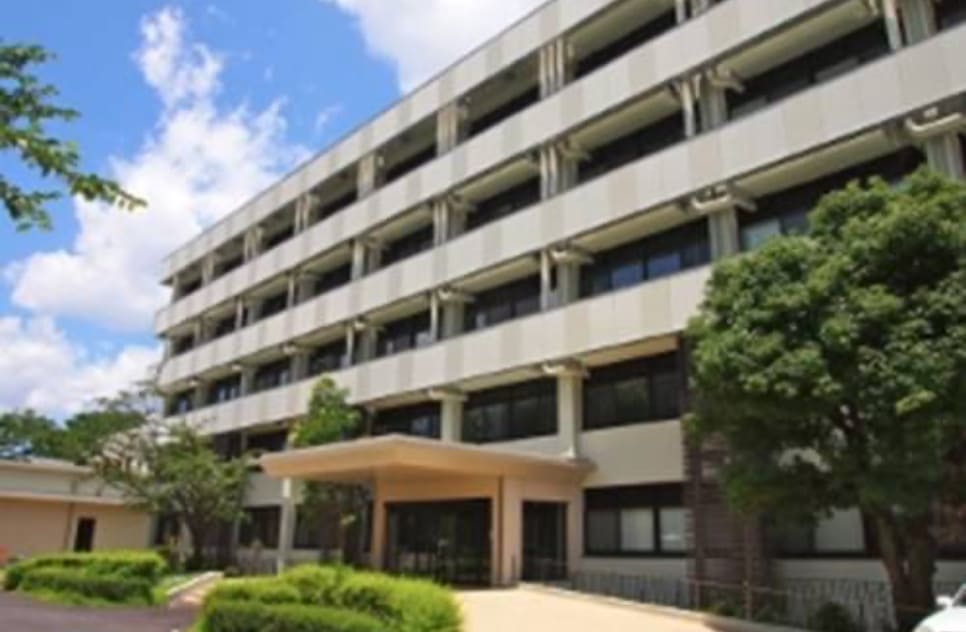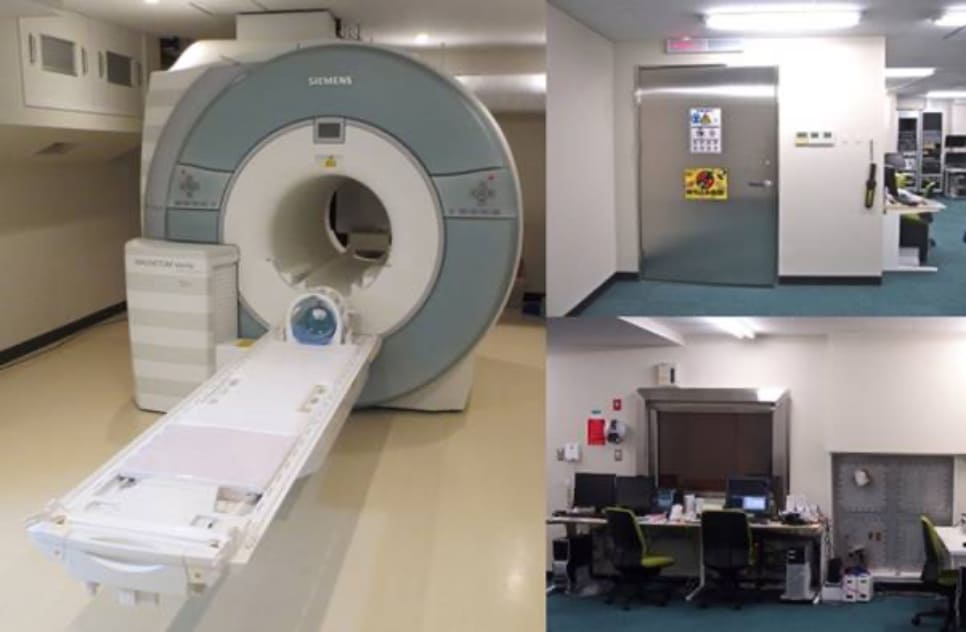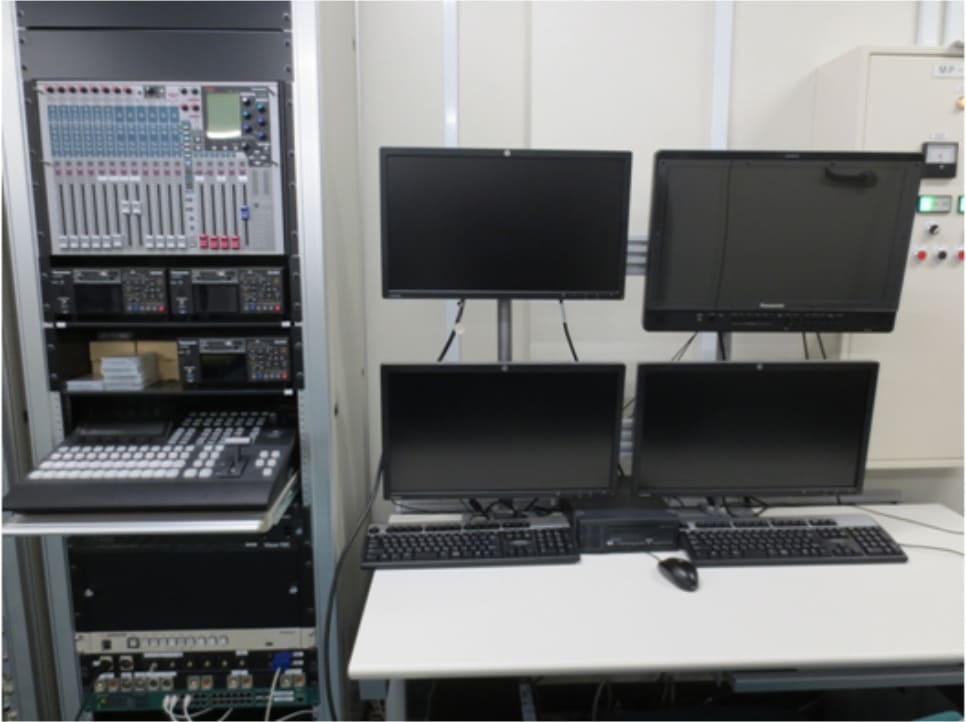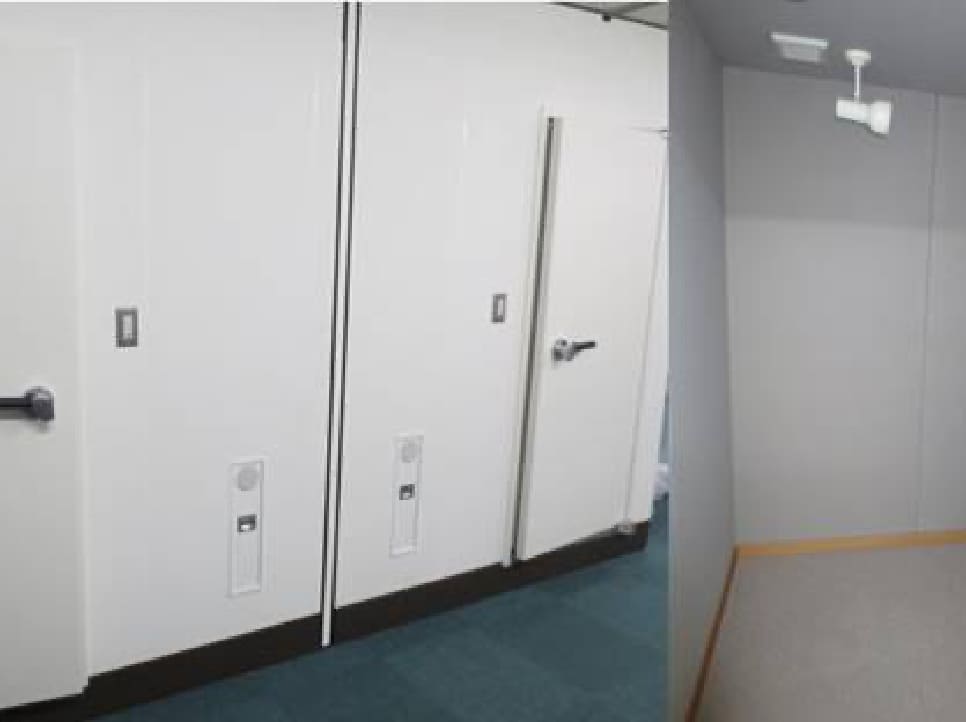- HOME
- >
- MRI

Collaborative MRI Research Facility
In March 2012, Institute for the Future of Human Society (IFOHS, formerly known as Kokoro Research Center) inaugurated the IFOHS Collaborative MRI Research Facility with the funding support of Japan Society for the Promotion of Science. The IFOHS MRI Research Facility houses a high-magnetic-field (3-T) MRI scanner and is equipped with other features including a "communication signal mediation and relay system" which allows participant interaction inside and outside the MRI scanner and anechoic chambers, offering an ideal research environment. In addition to active utilization in advanced research in the field of cognitive neuroscience, the IFOHS MRI Facility is widely used for educational and outreach activities.
Equipment Overview
The IFOHS MRI Research Facility is equipped with a SIEMENS-manufactured 3T MRI system, the “Magnetom Verio.” For functional magnetic resonance imaging (fMRI) experiments, dedicated PCs have been installed for presenting visual and auditory stimuli, along with systems for recording synchronized signals from the MRI system and subjects' responses. The facility also features multiple interfaces, enabling easy integration of external PCs for experiments.
One of the facility’s unique features is a communication signal mediation and relay system, which not only records the facial expressions and gaze of subjects inside the MRI machine but also captures brain activity linked to real-time interactions with people outside the MRI machine. Additionally, the facility houses two soundproof chambers designed for psychological and behavioral experiments conducted before and after MRI sessions. These chambers offer excellent sound insulation, ensuring experiments can be conducted in a controlled environment.
-

South Research Bldg. No.1.
-

SIEMENS 3T-MRI Magnetom Verio
-

communication signal mediation and relay system
-

sound-proof chamber
Operational Structure
Under the leadership of Professor Nobuhito Abe, several research staff members oversee the operations of the Collaborative MRI Research Facility. In addition, two committees—the Steering Committee and the Safety Committee—have been established, consisting of researchers not only from the IFOHS but also from various departments across the university.
The Steering Committee continuously reviews and discusses the overall management policies of the MRI facility, including the use of its equipment. The Safety Committee assesses the safety of research projects and formulates rules for the facility's safety management.
The facility has established a set of guidelines that outlines the rules and regulations for the smooth operation of the MRI system by researchers. Based on these guidelines, users are required to submit an application for the safety review of their research projects, which must first be approved by the Ethical Review Committee. Once submitted, each application is promptly reviewed by the Safety Committee to ensure seamless collaborative use. Additionally, all users of the facility are required to attend a safety workshop in advance, to ensure they fully understand the importance of maintaining the highest safety standards during experiments.
Facility Staff
The following members are responsible for the maintenance and management of the Collaborative MRI Research Facility:
-
Faculty
Nobuhito Abe, Professor
Ryusuke Nakai, Program-Specific Associate Professor
Ryuhei Ueda, Assistant Professor
-
Researchers
Nanae Matsumoto
Kohei Asano
Maki Terao
Research Use
By the end of FY2023, the Collaborative MRI Research Facility had received a total of 136 applications for research projects and is widely utilized by many researchers. More than 150 presentations of research results using our MRI system have been made at domestic and international academic conferences and research meetings. Additionally, a total of 63 original research papers have been published in English, appearing in journals such as Neuroimage, Cerebral Cortex, Psychological Science, Journal of Experimental Psychology: General, and other neuroscience and psychology journals, as well as high-impact journals like PNAS and Science Advances.
We aim to continue encouraging researchers to actively use the facility and strive to maintain an environment that promotes the dissemination of cutting-edge research findings.
Educational Use
The facility continuously offers its own educational programs. Specifically, we regularly hold hands-on fMRI seminars for beginners, fMRI analysis seminars for experienced data analysts, and intensive neuroscience lectures. The hands-on fMRI seminars are primarily for graduate and undergraduate students, as well as on-campus researchers, and include lectures on functional brain imaging research, opportunities to participate in MRI experiments, and the chance to analyze their own brain data.
The fMRI Analysis Seminar offers advanced lectures on image analysis combined with hands-on practice. Each participant uses their own PC to work directly with the data, gaining practical experience in analysis techniques. The neuroscience intensive lecture invites participants from both within and outside the university for a two-day event, featuring a leading lecturer who covers the fundamentals of neuroscience along with the latest research findings. We plan to continue these educational programs to expand the base of MRI users and equip them with cutting-edge knowledge and techniques, in collaboration with researchers from both inside and outside the university.
The facility’s MRI system is also utilized effectively in undergraduate and graduate education, with several courses incorporating tours of the MRI system. Additionally, the facility is widely used for outreach initiatives, such as tours for high school students.
Publications
-
1. Cheng FL, Horikawa T, Majima K, Tanaka M, Abdelhack M, Aoki SC, Hirano J, Kamitani Y (2023)
Reconstructing visual illusory experiences from human brain activity.
Science Advance 9(46): eadj390 -
2. Ho JK, Horikawa T, Majima K, Cheng F, Kamitani Y (2023)
Inter-individual deep image reconstruction via hierarchical neural code conversion.
Neuroimage 271: 120007. -
3. Mihara M, Izumika R, Tsukiura T (2023)
Remembering unexpected beauty: Contributions of the ventral striatum to the processing of reward prediction errors regarding the facial attractiveness in face memory.
Neuroimage 282:120408 -
4. Sato W, Nakazawa A, Yoshikawa S, Kochiyama T, Honda M, Gineste Y (2023)
Behavioral and neural underpinnings of empathic characteristics in a Humanitude-care expert.
Frontiers in Medicine 10: 1059203. -
5. Fukumoto Y, Taniguchi M, Hirono T, Yagi M, Yamagata M, Nakai R, Yamada Y, Kimura M,Ichihashi N (2023)
Association of Regional Muscle Thickness and Echo Intensity with Muscle Volume, Intramuscular Adipose Tissue, and Strength of the Quadriceps Femoris.
Clinical Interventions in Aging 18: 1513-1521 -
6. Chester SC, Ogawa T, Terao M, Nakai R, Abe N, De Brito SA (2023)
Cortical and subcortical grey matter correlates of psychopathic traits in a Japanese community sample of young adults: Sex and configurations of factors’ level matter!
Cerebral Cortex 33: 5043-5054 -
7. Diaz-Rojas F, Matsunaga M, Tanaka Y, Kikusui T, Mogi K, Nagasawa M, Asano K, Abe N, Myowa M (2023)
Development of the paternal brain in humans throughout pregnancy
Journal of Cognitive Neuroscience 35 (3): 396-420 -
8. Hsu CT, Sato W, Kochiyama T, Nakai R, Asano K, Abe N, Yoshikawa S (2022)
Enhanced mirror neuron network activity and effective connectivity during live interaction among female subjects
Neuroimage 263: 119655 -
9. Takeuchi H, Yahata N, Lisi G, Tsurumi K, Yoshihara Y, Kawada R, Murao T, Mizuta H, Yokomoto T, Miyagi T, Nakagami Y, Yoshioka T, Yoshimoto J, Kawato M, Murai T, Morimoto J, Takahashi H(2022)
Development of a classifier for gambling disorder based on functional connections between brain regions.
Psychiatry and Clinical Neurosciences 76(6): 260-267 -
10. Izumika R, Cabeza R, Tsukiura T (2022)
Neural Mechanisms of Perceiving and Subsequently Recollecting Emotional Facial Expressions in Young and Older Adults
Journal of Cognitive Neuroscience 34(7): 1183-1204 -
11. Fukumoto Y, Taniguchi M, Hirono T, Yagi M, Yamagata M, Nakai R, Asai T, Yamada Y, Kimura M, Ichihashi N (2022)
Influence of ultrasound focus depth on the association between echo intensity and intramuscular adipose tissue
Muscle and Nerve 66 (5): 568-575 -
12. Takano R, Nomura M (2022)
Neural representations of awe: Distinguishing common and distinct neural mechanisms
Emotion 22 (4): 669-677 -
13. Horikawa T, Kamitani Y (2022)
Attention modulates neural representation to render reconstructions according to subjective appearance.
Communications Biology 5: 34 -
14. Ueda R, Abe N (2021)
Neural representations of the committed romantic partner in the nucleus accumbens.
Psychological Science 32: 1884-1895 -
15. Yamashita M, Ohsawa C, Suzuki M, Guo X, Sadakata M, Otsuka Y, Asano K, Abe N, Sekiyama K(2022)
Neural advantages of older musicians involve the cerebellum: Implications for healthy aging through lifelong musical instrument training.
Frontiers in Human Neuroscience 15: 784026 -
16. Yanagisawa K, Kashima ES, Shigemune Y, Nakai R, Abe N (2021)
Neural representations of death in the cortical midline structures promote temporal discounting.
Cerebral Cortex Communications 22: tgab013 -
17. Yamashita M, Suzuki M, Kawagoe T, Asano K, Futada M, Nakai R, Abe N, Sekiyama K (2021)
Impact of early-commenced and continued sports training on the precuneus in older athletes
Frontiers in Human Neuroscience 15:766935 -
18. Soshi T, Andersson M, Kawagoe T, Nishiguchi S, Yamada M, Otsuka Y, Nakai R, Abe N, Aslah A, Igasaki T, Sekiyama K (2021)
Prefrontal plasticity after a 3-month exercise intervention in older adults relates to enhanced cognitive performance
Cerebral Cortex 31: 4501-4517 -
19. Taniguchi M, Yamada Y, Yagi M, Nakai R, Tateuchi H, Ichihashi N (2021)
Estimating thigh skeletal muscle volume using multi-frequency segmental-bioelectrical impedance analysis
Journal of Physiological Anthropology 40: 130 -
20. Tsuruha E, Tsukiura T (2021)
Effects of aging on the neural mechanisms underlying the recollection of memories encoded by social interactions with persons in the same and different age groups
Frontiers in Behavioral Neuroscience 15: 743064 -
21. Nonaka S, Majima K, Aoki SC, Kamitani Y (2021)
Brain hierarchy score: Which deep neural networks are hierarchically brain-like?
iScience 24: 103013 -
22. Guo X, Yamashita M, Suzuki M, Ohsawa C, Asano K, Abe N, Soshi T, Sekiyama K (2021)
Musical instrument training program improves verbal memory and neural efficiency in novice older adults
Human Brain Mapping 42: 1359-1375 -
23. Sugimoto H, Dolcos F, Tsukiura T (2021)
Memory of my victory and your defeat: Contributions of reward- and memory-related regions to the encoding of winning events in competitions with others
Neuropsychologia 152: 107733 -
24. Katsumi Y, Kondo N, Dolcos S, Dolcos F, Tsukiura T (2021)
Intrinsic functional network contributions to the relationship between trait empathy and subjective happiness
Neuroimage 227: 117650 -
25. Diaz-Rojas F, Matsunaga M, Tanaka Y, Kikusui T, Mogi K, Nagasawa M, Asano K, Abe N, Myowa M (2021)
Development of the paternal brain in expectant fathers during early pregnancy
Neuroimage 225: 117527 -
26. Tei S, Kauppi JP, Jankowski KF, Fujino J, Monti RP, Tohka J, Abe N, Murai T, Takahashi H, Hari R (2020)
Brain and behavioral alterations in subjects with social anxiety dominated by empathic embarrassment
Proceedings of the National Academy of Sciences of the United States of America 117(8): 4385-4391 -
27. Fujimichi M, Yamamoto H, Saiki J (2020)
The limited contribution of early visual cortex in visual working memory for surface roughness
Experimental Brain Research 238(10): 2189-2197 -
28. Fujimichi M, Yamamoto H, Saiki J (2020)
Functional difference between the ventral visual cortex and the intraparietal sulcus in visual working memory of material properties
Neuroreport 31(14): 1042-1047 -
29. Otsuka S, Saiki J (2020)
Neural mechanisms of memory enhancement and impairment induced by visual statistical learning
Journal of Cognitive Neuroscience 32(9): 1749-1763 -
30. Matsumoto N, Nakai R, Ino T, Mitani A (2020)
Brain activity associated with the rubber foot illusion
Neuroscience Letters 721: 134820 -
31. Horikawa T, Cowen AS, Keltner D, Kamitani Y (2020)
The neural representation of visually evoked emotion is high-dimensional, categorical, and distributed across transmodal brain regions
iScience 223(5): 101060 -
32. Sato W, Kochiyama T, Minemoto K, Sawada R, Fushiki T (2019)
Amygdala activation during unconscious visual processing of food
Scientific Reports 9: 7277 -
33. Otsuka S, Saiki J (2019)
Neural correlates of visual short-term memory for objects with material categories
Heliyon 5: e03032 -
34. Kajimura S, Kochiyama T, Abe N, Nomura M (2019)
Challenge to unity: Relationship between hemispheric asymmetry of the default mode network and mind wandering
Cerebral Cortex 29 (5): 2061-2071 -
35. Tei S, Kauppi J, Fujino J, Jankowski K, Kawada R, Murai T, Takahashi H (2019)
Inter-subject correlation of temporoparietal junction activity is associated with conflict patterns during flexible decision-making
Neuroscience Research 144: 67-70 -
36. Shen G, Dwivedi K, Majima K, Horikawa T, Kamitani Y (2019)
End-to-end deep image reconstruction from human brain activity
Frontiers in Computational Neuroscience 13: 21 -
37. Shen G, Horikawa T, Majima K, Kamitani Y (2019)
Deep image reconstruction from human brain activity
PLoS Computational Biology 15 (1): e1006633 -
38. Fujino M, Ueda Y, Mizuhara H, Saiki J, Nomura M (2018)
Open monitoring meditation reduces the involvement of brain regions related to memory function
Scientific Reports 8 (1): 9968 -
39. Sato N, Mizuhara H (2018)
Successful encoding during natural reading is associated with fixation-related potentials and large-scale network deactivation
eNeuro 5 (5): ENEURO.0122-18.2018 -
40. Abdelhack M, Kamitani Y (2018)
Sharpening of hierarchical visual feature representations of blurred images
eNeuro, 5(3): ENEURO.0443-17.2018 -
41. Ueda R, Yanagisawa K, Ashida H, Abe N (2018)
Executive control and faithfulness: only long-term romantic relationships require prefrontal control
Experimental Brain Research 236: 821-828 -
42. Suzuki M, Kawagoe T, Nishiguchi S, Abe N, Otsuka Y, Nakai R, Asano K, Yamada M, Yoshikawa S, Sekiyama K (2018)
Neural correlates of working memory maintenance in advanced aging: Evidence from fMRI
Frontiers in Aging Neuroscience 10: 358 -
43. Ono M, Kochiyama T, Fujino J, Sozu T, Kawada R, Yokoyama N, Sugihara G, Murai T, Takahashi H (2018)
Self-efficacy modulates the neural correlates of craving in male smokers and ex-smokers: an fMRI study
Addiction Biology 23: 1179-1188 -
44. Uesaki M, Takemura H, Ashida H (2018)
Computational neuroanatomy of human stratum proprium of interparietal sulcus
Brain Structure & Function 223(1): 489-507 -
45. Yoneda M, Ueda R, Ashida H, Abe N (2017)
Automatic honesty forgoing reward acquisition and punishment avoidance: a functional MRI investigation
Neuroreport 28(14): 879-883 -
46. Ueda R, Yanagisawa K, Ashida H, Abe N (2017)
Implicit attitudes and executive control interact to regulate interest in extra-pair relationships
Cognitive Affective & Behavioral Neuroscience 17(6): 1210-1220 -
47. Tei S, Fujino J, Kawada R, Jankowski K, Kauppi J, van den Bos W, Abe N, Sugihara G, Miyata J, Murai T, Takahashi H (2017)
Collaborative roles of temporoparietal junction and dorsolateral prefrontal cortex in different types of behavioural flexibility
Scientific Reports 7 (1): 6415 -
48. Otsuka S, Saiki J (2017)
Neural correlates of implicit knowledge about statistical regularities
Experimental Brain Research 235(12): 3573-3583 -
49. Onojima T, Kitajo K, Mizuhara H (2017)
Ongoing slow oscillatory phase modulates speech intelligibility in cooperation with motor cortical activity
Plos One 12(8): e0183146 -
50. Kitayama S, Yanagisawa K, Ito A, Ueda R, Uchida Y, Abe N (2017)
Reduced orbitofrontal cortical volume is associated with interdependent self-construal
Proceedings of the National Academy of Sciences of the United States of America 114(30): 7969-7974. -
51. Fujino J, Tei S, Jankowski K, Kawada R, Murai T, Takahashi H (2017)
Role of spontaneous brain activity in explicit and implicit aspects of cognitive flexibility under socially conflicting situations: A resting-state fMRI study using fractional amplitude of low-frequency fluctuations
Neuroscience 367: 60-71 -
52. Fujimoto A, Tsurumi K, Kawada R, Murao T, Takeuchi H, Murai T, Takahashi H (2017)
Deficit of state-dependent risk attitude modulation in gambling disorder
Translational Psychiatry 7 (4): e1085 -
53. Iseki R, Kajima S, Zhao X, Liang X, Tsujimoto S (2017)
The role of presenter actions in the evaluation of oral presentations: Evidence from fMRI and motion-vector analysis
Psychologia 60 (1): 44-55 -
54. Kaneda T, Shigemune Y, Tsukiura T (2017)
Lateral and medial prefrontal contributions to emotion generation by semantic elaboration during episodic encoding
Cognitive, Affective, and Behavioral Neuroscience 17: 143-157 -
55. Ueda R, Ashida H, Yanagisawa K, Abe N (2017)
The neural basis of individual differences in mate poaching
Social Neuroscience 12 (4): 391-399 -
56. Fujimoto A, Takahashi H (2016)
Flexible modulation of risk attitude during decision-making under quota
Neuroimage 139: 304-312 -
57. Sugimoto H, Shigemune Y, Tsukiura T (2016)
Competing against a familiar friend: Interactive mechanism of the temporo-parietal junction with the reward-related regions during episodic encoding
Neuroimage 130: 261-272 -
58. Yanagisawa K, Abe N, Kashima ES, Nomura M (2016)
Self-esteem modulates amygdala-ventrolateral prefrontal cortex connectivity in response to mortality threats
Journal of Experimental Psychology: General 145 (3): 273-283 -
59. Kajimura S, Kochiyama T, Nakai R, Abe N, Nomura M (2016)
Causal relationship between effective connectivity within the default mode network and mind-wandering regulation and facilitation
Neuroimage 133: 21-30 -
60. Uesaki M, Ashida H (2015)
Optic-flow selective cortical sensory regions associated with self-reported states of vection
Frontiers in Psychology 6:775 -
61. Kajimura S, Kochiyama T, Nakai R, Abe N, Nomura M (2015)
Fear of negative evaluation is associated with altered brain function in nonclinical subjects
Psychiatry Research: Neuroimaging 234 (3): 362-368 -
62. Kawagoe T, Suzuki M, Nishiguchi S, Abe N, Otsuka Y, Nakai R, Yamada M, Yoshikawa S, Sekiyama K (2015)
Brain activation during visual working memory correlates with behavioral mobility performance in older adults
Frontiers in Aging Neuroscience 7: 186 -
63. Nishiguchi S, Yamada M, Tanigawa T, Sekiyama K, Kawagoe T, Suzuki M, Yoshikawa S, Abe N, Otsuka Y, Nakai R, Aoyama T, Tsuboyama T (2015)
A 12-week physical and cognitive exercise program can improve cognitive function and neural efficiency in community-dwelling older adults: a randomized controlled trial
Journal of the American Geriatrics Society 63 (7): 1355-1363

